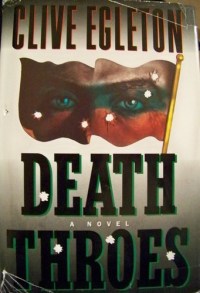Kingfisher by Gerald Seymour
 Monday, January 10, 2011 at 11:07PM
Monday, January 10, 2011 at 11:07PM 
First published in 1977
To make a political statement about the plight of Ukrainian Jews, four individuals conspire to murder a police officer in Kiev. Moses Albyov, chosen by lot to pull the trigger, botches the killing, leaving the wounded officer alive to describe him. After his arrest, the remaining cell members, David, Isaac, and Rebecca, fearful that Moses will identify them, decide to hijack a plane and flee to Israel. Charlie Webster, an analyst for the SIS who tracks Soviet dissidents, plays a central role in communicating with the hijackers.
What does the kingfisher have to do with any of this? "She is fast and swift, and she holds the initiative in her world. None can catch her, few even see her, she is devastating in her attack." That description of the kingfisher comes from the old soldier who provides arms to David for use in the hijacking. David, a naive young man who pictures himself as heroic until doubt and his conscience begin to trouble him, announces on the plane's radio that he is a Jewish Resistance Commando and names the flight "the Kingfisher."
Kingfisher is a solid thriller. Through much of the novel, the perspective is that of the hijackers, who justify their actions (at least initially) as a necessary response to oppression. At other times the reader sees the hijacking through different eyes: the passengers, European and Israeli politicians, German veterans who watch the plane overfly the Hanover airport, European Jews who once lived in Russia, and Webster are among those who contribute opinions about the hijackers. Kingfisher makes the point that one person's terrorist is another person's freedom fighter -- an observation that may have been clichéd even when the novel was published in 1977, but that nonetheless remains salient. In any event, the shifting perspectives add complexity and interest to the story.
Readers who prefer novels that feature morally pure heroes defeating cartoonishly evil bad guys will probably dislike Kingfisher. Gerald Seymour's strength is his ability to dramatize moral ambiguity. In Kingfisher, the reader understands and sympathizes with the hijackers despite their repellent actions. Similarly, the reader sympathizes with Webster, who is forced to make a difficult moral choice at the end of the novel. The difference between right and wrong is rarely clear in Seymour's novels. I like that reflection of reality, but readers who prefer the kind of escapist fiction that draws a distinct line between good and evil should probably avoid Seymour.
A minor quibble: the dialog spoken by Americans sounds very British. Other than that, Seymour's writing is strong, his characters are believable, and the pace is perfect. Seymour is an under-appreciated writer whose novels deserve a wider audience. Although Kingfisher is a bit dated (the hijacking described in the novel probably couldn't happen today, even in Kiev), the reader will quickly be drawn into the story, captivated by the mounting tension and the evolving personalities of the hijackers.
RECOMMENDED
 TChris |
TChris |  Post a Comment |
Post a Comment |  GGerald Seymour,
GGerald Seymour,  spy in
spy in  Thriller
Thriller 


